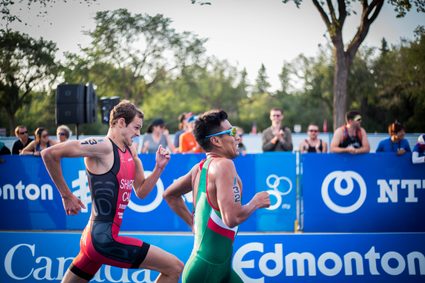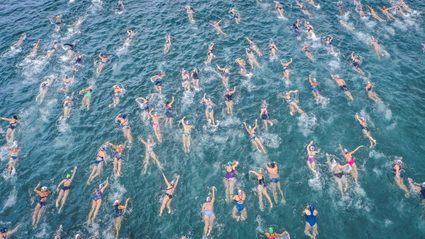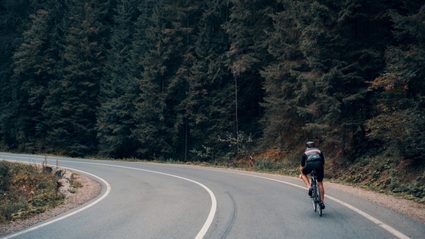Triathlon Nutrition Calculator
Spring – the time when trees bloom, the temperature rises, and triathletes go out to run, bike, and swim in preparation for the triathlon season. Apart from proper physical readiness, they will need to get the right nutrition during their workouts and races. That's why, in cooperation with "Triathlon" Taren Gesell, who is the author of , we created a tool to help any triathletes out there learn how to eat to keep their energy high during training and races in the upcoming season!
Whether you're planning your first triathlon or you're already an accomplished triathlete, this calculator is for you! With as little information as your weight and your target time, we can calculate how many calories you will burn and how many you should replace to be at your best. We'll also explain when, what (and why) to eat during a triathlon so that you can stay energized! 🏊🏽♀️🚴🏻♀️🏃🏼♀️
First, let's go into more detail on why you need to eat during long-distance races (and workouts!).
Why is nutrition important for triathlons?
The human body can store energy, which means that we are not dependent on constant eating and can survive some time without food. Fat tissue is one of the ways of storing energy, but think of it more as energy 'for a rainy day' – it takes some time to both gain fat tissue and to get rid of it (everybody who ever tried to lose weight knows what we're talking about 😉). Luckily, we also have another energy reserve that can be used quickly – glycogen.
Glycogen is a polysaccharide of glucose stored in the liver (5% of the livers mass) and skeletal muscles (0.7%). An average human with an average muscle mass has 500g of glycogen total in their body, which provides approximately 2000kcal. Seems a lot? Yes, but for an incredible feat like a triathlon, it's not even close to enough!
That's why during long-distance races, you need to focus on carbohydrates – the primary source of easily accessible energy. They will keep your blood sugar level right and keep you in the highest gear. When choosing your snacks, keep in mind they should not contain high amounts of fat or proteins – although in the regular diet they're super important, they prolong the process of breaking down nutrients. Eating a fat bomb during triathlon will not only cut off your energy supply, but can also give you gastrointestinal problems. Let's be honest – that's the last thing that you want during a race.
Good examples of race snacks include:
- 🍯 Energy gels – now you even have more natural options, like honey-based gels.
- 🍫 Energy bars – good choice, but notice they're usually solid and dry – try to eat them with water or another drink.
- 🍇 Dried fruit – dates, prunes, apricots, figs, raisins (you might want to try chocolate-covered raisins as well), etc.
- 🍌 Ripe bananas – bananas are athlete's best friends! Aim for ripe bananas, as they have a higher amount of simple sugars than green ones and are easier to digest.
- 🍞 Sesame bars – rich in fats but useful for variety
- 🍪 Homemade snacks – like energy balls or small pieces of energy bars. Awesome if you find cooking fun, and you can make countless versions. Use dried fruits, nuts, peanut butter, honey, oats, and your imagination!
- 🍬 Jellied sweets, chews, gummies – easily accessible and yummy!
Whatever you choose, you should first try it a few times during your regular training sessions. See if you prefer gels over solid foods (or the opposite), how your stomach reacts to what you eat, and what gives you the most energy. Don't experiment during the race! Choose the old, reliable options.
What and when to eat during a race?
Now that you know why and what you should eat, let's answer another question – when?
You need to consider two things – the metabolism of carbohydrates and the structure of the triathlon race. It takes about 30 minutes for the carbohydrates to be absorbed. To prevent you from sudden energy drops, you should start eating in the first hour of your race, even though you won't feel the need to eat. Then keep snacking every thirty minutes. 🍫
You should aim to drink 16 ounces of fluids of a light electrolyte drink each hour. Do so by taking a large sip each minute. If you start burping, slow down your drinking. If you feel an upset stomach, switch from the electrolyte solution to water until your stomach feels better, then switch back to the electrolyte drink.
-
Before the race 🏁
The problem is that the first part of a triathlon is swimming, where eating is not only extremely uncomfortable, but also dangerous. To keep you fueled during this part, treat your pre-race time as a part of the competition – start eating. Eat the first high carb snack 15-30 minutes before diving in. Test the timing and type of snack at home first so that you don't end up with a stitch!
At T1 (first transition – from swimming to bike), focus on a quick clothes change and don't bother yourself with food, unless you really need to – e.g., you feel your energy going down.
-
After jumping on a bike 🚴 🚴
Work for a while on getting the right pace, and after 5-10 minutes, eat something. Cycling triathlon training is the most comfortable time to eat during the whole race, so if you prefer more solid foods, this is the best time. Don't forget to sip your drinks every 5-7 minutes. If you feel thirsty, it means you haven't hydrated enough – increase the frequency at which you drink rather than drinking half of a bottle at once, as it may cause gastrointestinal discomfort and influence your performance.
Each snack during the cycling part should contain around 100 (90-110) kcal. Energy bars and gels usually have the energy content given on the package. 100 kcal means approximately:
-
A small to medium sized banana.
-
5 prunes.
-
2-3 dried figs.
-
A big handful of raisins.
-
7 dried dates.
-
A small to medium sized gummy bear.
The last snack for this part of the race should be eaten 10-15 minutes before the second transition. Again, don't lose precious time on eating during the transition.
-
-
On the run 🏃 🏃🏼
The rule is the same – a snack every 20-30 minutes. But notice that chewing solid bars now might be hard and uncomfortable. Focus on energy gels, dates, and soft ripe bananas. Sip your drinks every 5-7 minutes. Keep fueling yourself to maintain your best performance, and you'll be sure to get that PB(personal best)!

When to start preparing?
Don't feel intimidated by triathlons. You now know that in terms of nutrition, it comes down to having a few snacks and remembering to hydrate. But you may ask: what about fitness? It's okay if you let yourself go a bit over the winter, as triathlon season depends on the weather; you wouldn't want to freeze during the swimming part! Therefore it starts earlier in warm Florida than in rainy England. Usually most of the races take place from May to August. Find a sprint triathlon that's at least twelve weeks from now, and you'll be ready to go! You probably won't win your first one, but Triathlons aren't about winning or losing. They're about fighting our weaknesses. 🏅
Before you hop on a bike and ride a tremendous distance, which is likely to cause you an injury – do some research. Check out websites like , read some books about the topic, or consult a triathlon coach. One thing you can do without anyone's help is to check if you have all of the equipment needed. For swimming, you'll need a swimming suit, goggles, and (optionally) a cap. To cycle, you'll need a bike (a road/mountain bike will work just fine) with a bottle holder and (again optional) a pair of cycling shorts. All you need for running is a pair of good running shoes. Triathlon racing is not the cheapest sport... when you do it professionally. As a beginner, you don't need the best equipment, and most of these things you probably already have.

Tips for training
-
Get a fitness plan 📅
Workout around five times a week. An example of a good weekly plan would be two swimming practices, two biking plus running workouts, and one long bike ride. Don't strain your muscles too much. Start slowly and focus on the technique more than speed.
Would you like to know how long it would take you to prepare for a triathlon? You can learn that in our triathlon training calculator, where we tell you how many months and how many hours a week you should train for different types of triathlons.
-
Learn proper techniques
🏊♂️ It's crucial to learn a proper swimming technique, as well as keeping calm in the water. Most swimming parts of a triathlon take place in open water. There might be waves, strong streams, and for sure, there's going to be plenty of people pushing around. Consider approaching a swimming coach who will teach you how to check your direction and avoid panicking.
🚴♀️ Most of us learned how to ride a bike when we were children. What we weren't taught, though, is how to pedal to win a race. By learning pedaling techniques, you will save a lot of strength during the triathlon. And, believe me, you will need it for running.
🏃♂️ Running seems as the most 'no skills required' activity. In reality, running is the hardest part of the triathlon. Without leg muscle endurance and core strength you won't make it to the finish line. Start with lots of low intensity training. Slowly increase the distance with a few high intensity runs here and there. Also, learn how to land your feet properly.
-
Eat nutritious foods 🍌🥙🥦
Your diet shouldn't change much as you start training, as long as you were eating healthily. If not, it's time to cut out processed foods and sweets. Replace them with whole grains, fruits, vegetables, and good quality protein.
-
Rest 🛀
Don't overdo it! Plan recovery days, and award yourself from time to time with your favorite meal or snack. Maybe a bar of chocolate?

Triathlon statistics
The first record of the "Les trois sports" (trans. The three sports) was in 1901 in France. Men had to run, bike, and canoe 🛶 to be the victor. The triathlon, as we know it – with a swim instead of canoeing – came 20 years later. Since then, several types of these races have been created:
Name | Swim | Bike | Run |
|---|---|---|---|
Sprint | 0.47mi (750m) | 12mi (20km) | 3.1mi (5km) |
Olympic | 0.93mi (1.5km) | 25mi (40km) | 6.2mi (10km) |
70.3 Ironman | 1.2mi (1.9km) | 56mi (90km) | 13.1mi (21.1km) |
Full Ironman | 2.4mi (3.8km) | 112mi (180km) | 26.2mi (42.2km) |
Triathlons can take anywhere from a few dozen minutes up to several hours. The race is may be demanding, but that doesn't mean it's impossible. The oldest person who ever finished a Full Ironman was 85 years old!
The world record for the Full Ironman distance is 7 hours, 35 minutes, and 39 seconds. It was set by Jan Frodeno – German triathlete and Olympic champion. But starting a triathlon journey with 140-mile Ironman is probably not a good idea. A much better place to start is a Sprint triathlon. The fastest men complete this race in around 51 minutes. Women are just 4 minutes behind. As a beginner, if you finish it in around an hour and a half, you've done a great job! You can check the average finish times for other people of your age and sex in the average triathlon finish times calculator.
It's time to service your bike, dig out your running shoes, and don your swimming suit. The next couple of weeks won't be easy, but they will be worth it! Come back to our calculator whenever you need it. Before you go, learn how you can track your heart rate during your training for better race performance in the triathlon heart rate training zones calculator!🏁
Set your triathlon goal, type, target time and weight 💪